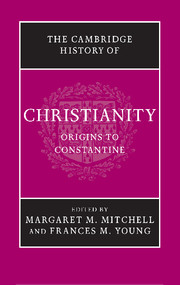Book contents
- Frontmatter
- Prelude: Jesus Christ, foundation of Christianity
- Part I The Political, Social and Religious Setting
- Part II The Jesus Movements
- Part III Community Traditions and Self-Definition
- Part IV Regional Varieties of Christianity in the First Three Centuries
- Part V The Shaping of Christian Theology
- Part VI ‘Aliens’ become Citizens: towards Imperial Patronage
- 28 Persecutions: genesis and legacy
- 29 Church and state up to c.300 ce
- 30 Constantine and the ‘peace of the church’
- 31 The first Council of Nicaea
- 32 Towards a Christian material culture
- Conclusion: retrospect and prospect
- Bibliographies
- Index
- Map 1. The Roman Empire in the time of Marcus Aurelius
- References
28 - Persecutions: genesis and legacy
from Part VI - ‘Aliens’ become Citizens: towards Imperial Patronage
Published online by Cambridge University Press: 28 March 2008
- Frontmatter
- Prelude: Jesus Christ, foundation of Christianity
- Part I The Political, Social and Religious Setting
- Part II The Jesus Movements
- Part III Community Traditions and Self-Definition
- Part IV Regional Varieties of Christianity in the First Three Centuries
- Part V The Shaping of Christian Theology
- Part VI ‘Aliens’ become Citizens: towards Imperial Patronage
- 28 Persecutions: genesis and legacy
- 29 Church and state up to c.300 ce
- 30 Constantine and the ‘peace of the church’
- 31 The first Council of Nicaea
- 32 Towards a Christian material culture
- Conclusion: retrospect and prospect
- Bibliographies
- Index
- Map 1. The Roman Empire in the time of Marcus Aurelius
- References
Summary
In the 250 years that separate the Neronian persecution in 64 ce from the conversion of Constantine to Christianity, c.312, Christianity was an illegal and suspect religion whose members were subject to arrest, condemnation and, in many cases, death. In the second century, acts of persecution would be carried out on the authority of provincial governors, but, in the third century, the emperors themselves began to become involved until under Valerian (253–60) edicts were promulgated through the senate that were aimed at suppressing the worship of the church and inflicting damage on its adherents. For their part, the Christians expected alienation from surrounding provincial society and subjection to persecution. Not all, however, were, like the deacon Euplus in Catania in 304, volunteer martyrs, but the tradition of righteous suffering, inherited from Judaism, was strong and was reinforced by the recorded example of Jesus himself, as well as the great prophets of Israel. Unfortunately for future history, the legacy of persecution, now aimed against heretics and non-believers, was not to die with the grant of toleration to the church.
The first encounter between the Christians and the Roman authorities was both fortuitous and disastrous. Up to the point at which Luke ends the Acts of the Apostles in 62 ce, relations with the provincial authorities had been tolerable. On arrival in Rome, Paul and his followers were still considered to be authentic, if suspect and unpopular, members of the Jewish community (cf. Acts 28:22).This relationship appeared unlikely to change in the next two years.
- Type
- Chapter
- Information
- The Cambridge History of Christianity , pp. 501 - 523Publisher: Cambridge University PressPrint publication year: 2006
References
- 3
- Cited by



